By far, one of the hardest skills to teach 4th and 5th graders is determining the main idea of a complex nonfiction text. Not only is determining main idea pretty difficult for some (or most depending on your class that year) students, but it is also so critical for understanding nonfiction text.
To make matters more complicated, so many other nonfiction skills are also dependent on understanding the main idea. To help my students master determining main idea, I strategically teach three different strategies or approaches.
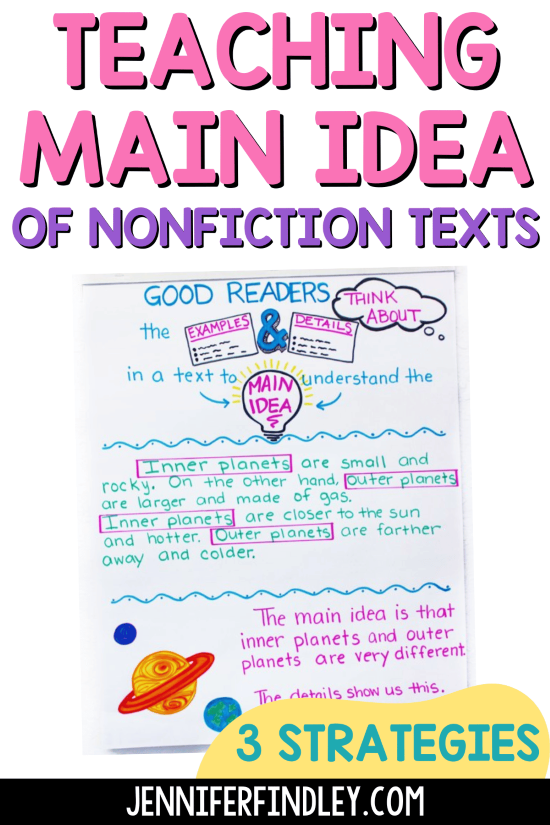
What is Main Idea?
The main idea is the most important idea in a text or what the text is mostly about. The main idea is sometimes stated in the opening sentence or paragraph of a text, but not always. Sometimes, the author will even state the main idea more than once. Other times, students have to figure out what the main idea is based on the important details in the text. This is when it gets tricky for students.
Why is Main Idea Tricky for Students?
Teaching the main idea of nonfiction text can be tricky because students often struggle with the embedded or related skills needed. In order to identify the main idea of a nonfiction text, students need to comprehend the text they are reading (including reading and understanding the vocabulary), identify the key details, distinguish between important details and interesting details, and determine how those details connect or relate to one another.
It is pretty easy to see why this is such a tricky skill for students.
Let’s take a look at the three strategies and approaches I use to teach main idea.
Main Idea Strategy #1: Using Key Words
When teaching the main idea, one strategy you can use is to have students identify key words in the text. Key words are usually repeated throughout the text and can help readers identify the main idea. After identifying key words, have students can use them to create a main idea sentence.
To begin the teaching of this specific main idea strategy, I like to read a high interest article (for this lesson I used an article from Zoobooks about Owls) projected onto the smartboard. I prefer to use a digital article because I can annotate the article on my smartboard as I model the strategy.
Here is the main idea anchor chart that I used to introduce this main idea strategy:

During the lesson, I explicitly taught the students that key words are either bolded, repeated (keeping in mind words that are repeated through synonyms), or match the heading or the title.
With the students’ help, we came up with four key words from a paragraph in our article (specifically zoning in on one paragraph at a time is key to scaffolding understanding). We supported the choice of key words by discussing which requirement they met to be called a key word. Then we turned our key words into a main idea sentence.
Finally, we completed what I call a “Sentence Check.” This is where we check each sentence (or randomly select a few) to make sure they match or support the main idea. If each sentence is not connected to the main idea in some way, our main idea sentence may not be accurate or complete. This really helps students not choose main idea sentences that are just interesting details.
Main Idea Strategy #2: What to Do When You Have Choices
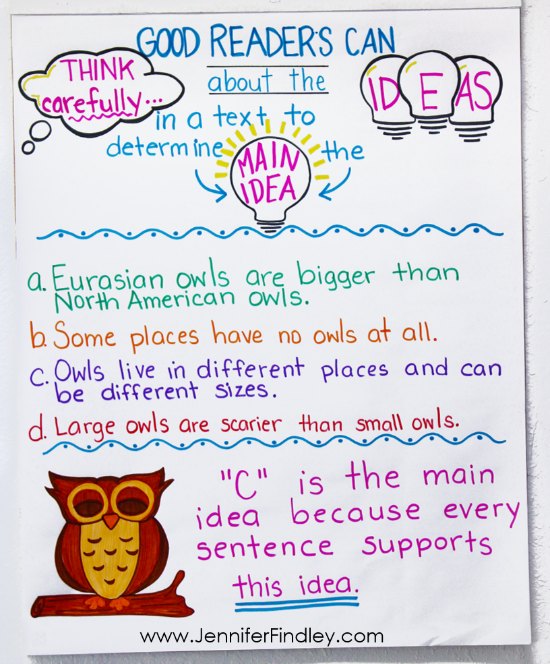
After reading the section and discussing with our partners what we thought the author was trying to tell us with the important details, we looked at our choices. We read each choice and went back to the section to determine if it was the main idea.
We used our “Sentence Check” from the previous lesson to justify our answers. It was really great hearing the students say things like, “That is just a detail, and the other sentences don’t really talk about that.” Or “That sentence is an opinion and doesn’t match the details in the paragraph.” We chose our answer if we could prove that all of our sentences in the specific paragraph supported that main idea.
Main Idea Strategy #3: What are the details or examples showing you?
The final main idea strategy focuses on looking at the important details shared in a text and seeing how they relate, connect, or what big idea they reveal about the topic.
For this lesson, we moved away from our article and used a nonfiction mentor text on sharks. For this lesson, I wanted to explore text that didn’t really have key words but instead used details and examples to illustrate the main idea. This book was perfect for that because it contained examples (and engaging ones) through the text and the illustrations.
Click here to see my other recommended mentor texts and read alouds for teaching main idea.
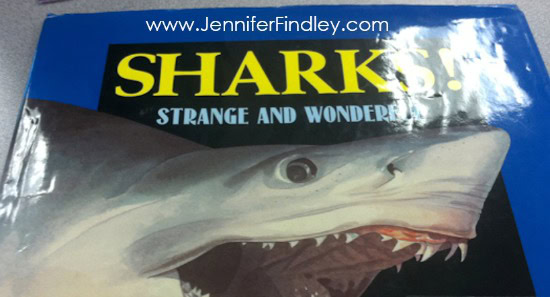
Before reading the shark mentor text, we looked at a quick example about planets that I had written on chart paper. We read it aloud and discussed with a partner what the author was trying to show us through the details provided.
Since this was a familiar topic, most of them were really quick to notice that the details were showing that the inner planets are different from the outer planets.
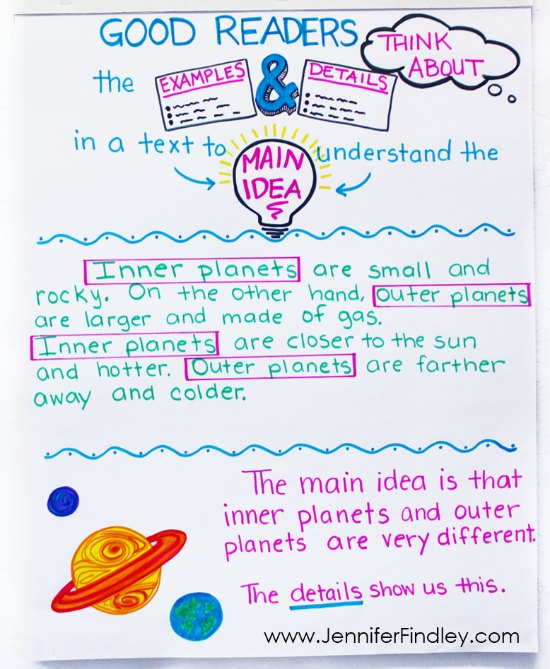
After reading the short paragraph, we discussed how the main idea was not stated or even shown through key words. Instead, the reader used the examples and the details to show the reader the main idea.
After discussing this and doing another turn and talk discussion with our partners, we read a few pages from the mentor text mentioned above.
We did several main idea sentences together using the book and then I chose a page for them to complete on their own. They were given a post it note where they had to determine the main idea. It was really interesting because some of them let the examples guide them, and some of them even chose to use key words to help them from our previous lessons. They posted their responses on our chart.
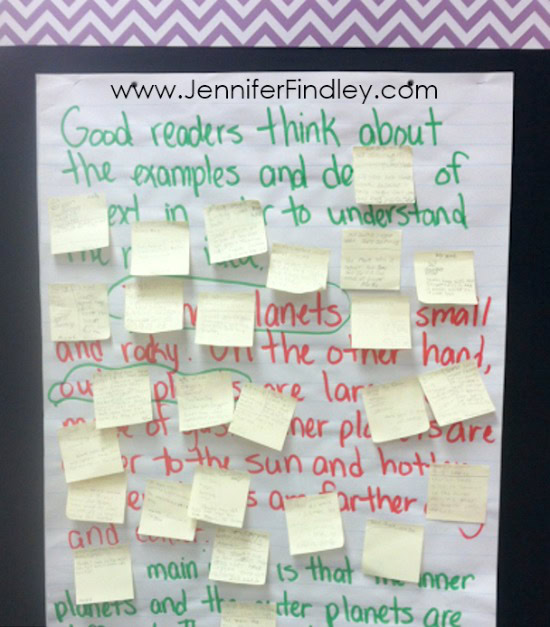
Do you need resources and activities for teaching main idea?

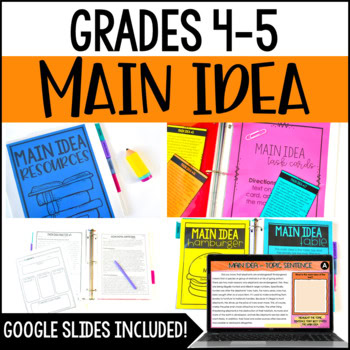







I just did a blog post about the FRAME strategy that we use to help students focus on main idea. It is super helpful when reading non-fiction text or to use within your science and social studies time. The Frame starts with the main topic (which is hopefully easier to find)- and then breaks it down from there. Main idea is so hard to teach…and a lot of text isn't written with that feature in mind! Good luck!
Real Teachers Learn
You're totally right- main idea is so tough for them! I like your anchor charts. I do them like you- short mini lesson statement, then we create the rest together. I think it's more meaningful for them that way!
Mandy
Caffeine and Lesson Plans
Thank you for the ideas. I plan to use this.
I LOVE THE DIFFERENT STRATEGIES THAT YOU ARE USING!! I WILL DEFINITELY IMPLEMENT THEM WHEN ITS TIME TO TEACH MI TO MY 4TH GRADERS!!
I read an article using “Chunking” the paragraphs. Numbering them.
Then using a Graphic Organizer (like a T-chart), students use “paraphrasing” skills.
Student ‘Summarizes each Numbered paragraph (Paragraph #1, Paragraph #2, etc) by writing 1 sentence “about what the paragraph was mostly about”.
Lastly, (on the Bottom of the page), the Student writes a Topic Sentence (incorporating the Main Idea), along with 3 supporting ideas.
This has been so incredibly helpful. I like giving students different opportunities to be successful. I’ve used this as my framework for main idea this year and it has been much more productive than in years previous. Thanks for this blog post!
Jennifer, I just want you to know how much I miss using your lessons and teaching materials!!! I moved to grade 2 from 4th and 5th and can not find other resources to use like the things YOU provided. Any chance you’re planning on switching grades;) I just wanted you to know how much I appreciated everything you’ve shared over the years. Thank you.